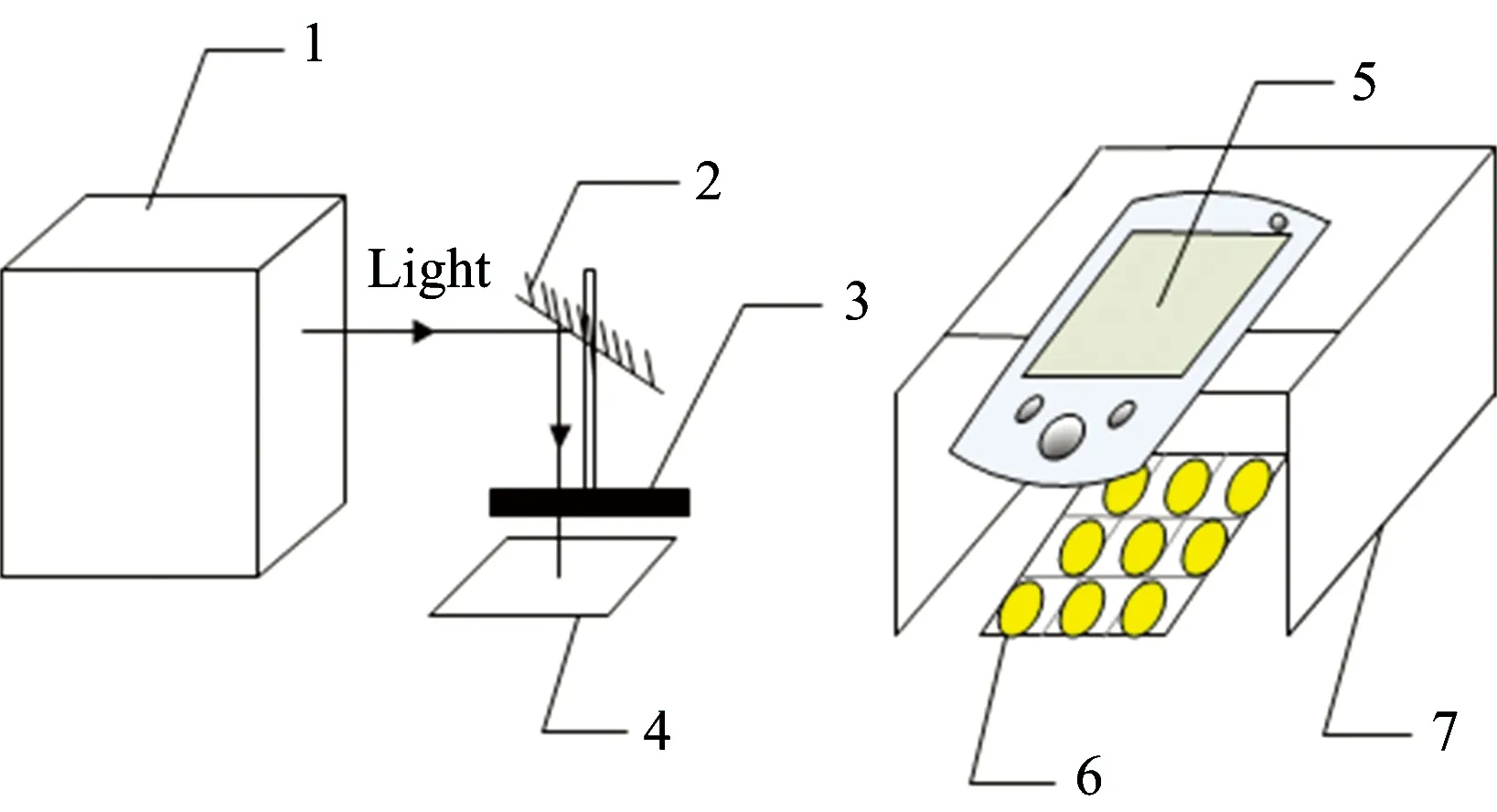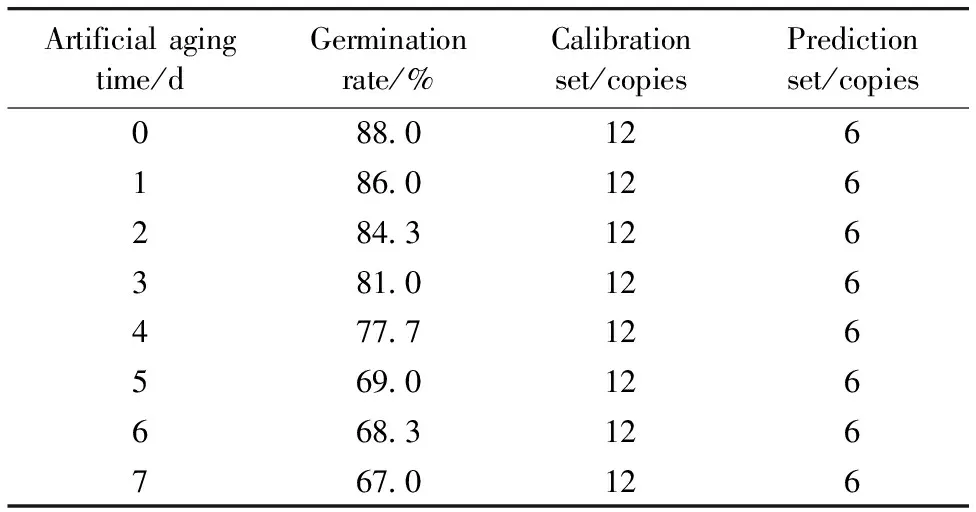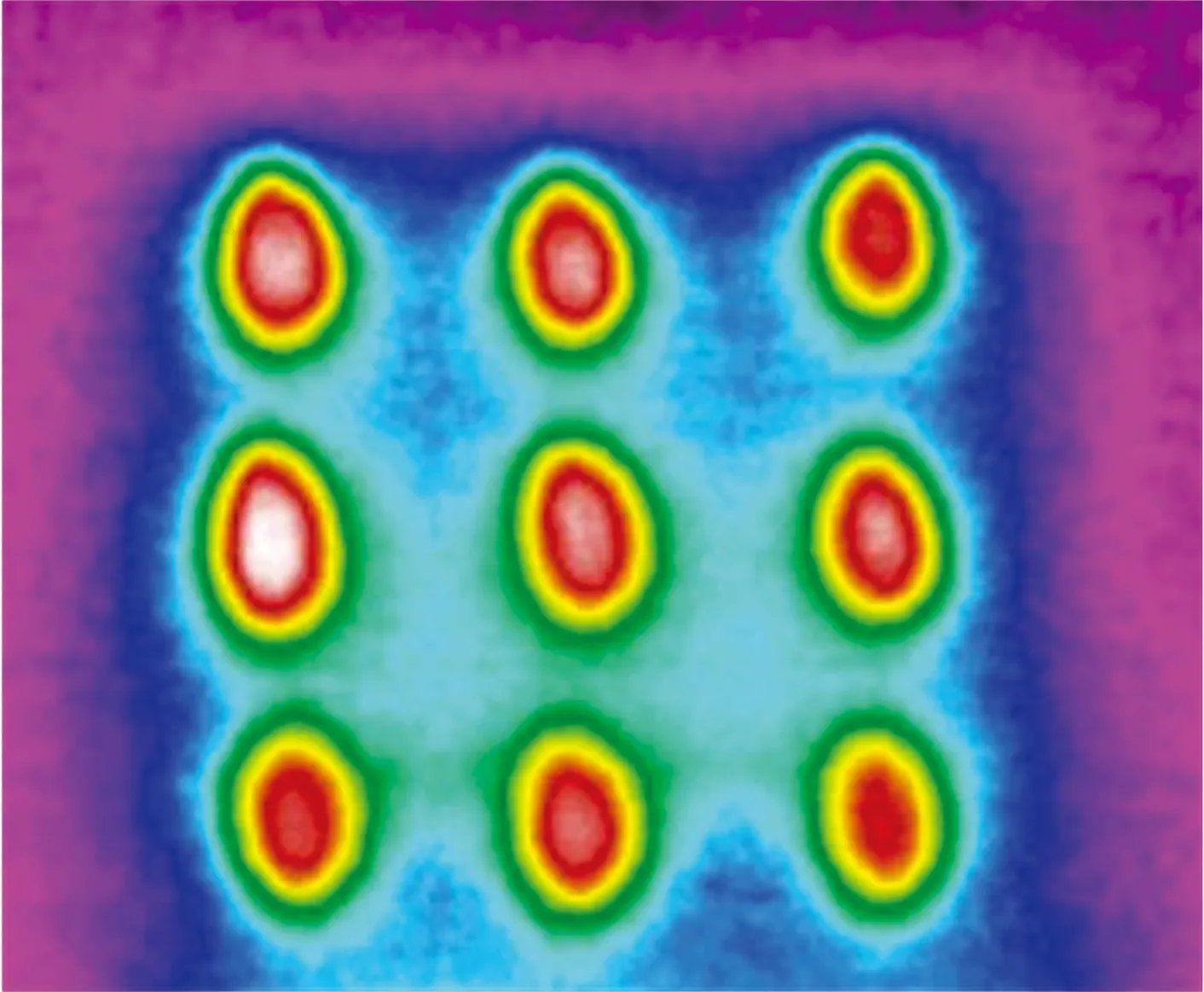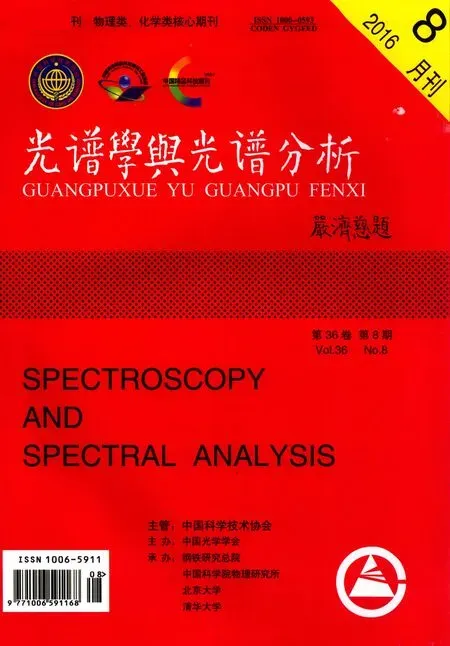Study on the Detection of Rice Seed Germination Rate Based on Infrared Thermal Imaging Technology Combined with Generalized Regression Neural Network
2016-06-15FANGWenhuiLUWeiXUHongliHONGDelinLIANGKun
FANG Wen-hui, LU Wei,2*, XU Hong-li, HONG De-lin, LIANG Kun
1. College of Engineering, Jiangsu Province Engineering Laboratory of Modern Facility Agriculture Technology and Equipment,Nanjing Agricultural University, Nanjing 210031, China
2. Key Laboratory of Remote Measurement and Control Technology of Jiangsu Province, Nanjing 210096, China
3. College of Agriculture/State Key Laboratory of Crop Genetics &Germplasm Enhancement,Nanjing Agricultural University, Nanjing 210095, China
Study on the Detection of Rice Seed Germination Rate Based on Infrared Thermal Imaging Technology Combined with Generalized Regression Neural Network
FANG Wen-hui1, LU Wei1,2*, XU Hong-li1, HONG De-lin3, LIANG Kun1
1. College of Engineering, Jiangsu Province Engineering Laboratory of Modern Facility Agriculture Technology and Equipment,Nanjing Agricultural University, Nanjing 210031, China
2. Key Laboratory of Remote Measurement and Control Technology of Jiangsu Province, Nanjing 210096, China
3. College of Agriculture/State Key Laboratory of Crop Genetics &Germplasm Enhancement,Nanjing Agricultural University, Nanjing 210095, China
On the basis of the differences in physiology and physics of rice seed with different aging time, the paper proposes a fast and nondestructive method which is based on infrared thermal imaging technology and generalized regression neural network to detect the germination rate of rice seed. This method solves the problems of long experimental period, complex operations and other disadvantages of the traditional method which is used to detect germination rate. When the temperature is 45 ℃ and humidity is 90%, the rice seeds are aged for 0, 1, 2, 3, 4, 5, 6 and 7 d respectively to get rice seeds of different germination rate. The data of 144 groups was extracted from the germ of rice seed. This data was divided into two groups randomly: the calibration set was 96 groups and the prediction set was 48 groups. Through analyzing and comparing the differences of infrared thermal image of rice seeds of different aging days, the relationship in physics and physiology between germination rate of rice seed and infrared thermal images was revealed. The infrared prediction model for germination rate of rice seed was established by combining partial least squares algorithm, Back Propagationneural network and General regression neural network. The result shows that the optimal germination rate model is built with GRNN. In this model, the correlation coefficient (RC) and standard deviation (SEC) of calibration sets are 0.932 0 and 2.056 0. At the same time, the correlation coefficient (RP) and standard deviation (SEP) of prediction sets are 0.900 3 and 4.101 2. The relevance reaches a higher level and the standard deviation is small. Therefore, the experiment shows that combining infrared thermal imaging technology with GRNN to study germination rate of rice seed is feasible. The model has a higher accuracy in terms of rapid determination of the germination rate of rice seed.
Infrared thermal imaging technology; Rice seed;Germination rate; Nondestructive detecting; GRNN
Introduction
Food is a basic material security of people’s life. According to the data from “Chinese Statistical Yearbook” published in 2014, the acreage sown of rice reached 30 312 000 hectares and its output reached 203.612 million tons in China in 2013. The production of rice affects Chinese grain problem directly. Therefore, food production has become a hot issue in these years. The germination rate of rice seed is one of the basic, common and indispensable quality indicators to detect rice seed. To some extent, it affects food production[1].
Currently, germination test method, which is the most common method to detect germination rate of rice seed. It not only requires preprocessing rice seed before experiment but also needs test environment to stimulate various indicators of rice seed which grows in natural environment. The experimental environment is demanding and requires long experimental period. At the same time, it is affected by the impact of seed dormant period easily. In addition to conventional detection methods, Wang Chunfang et al realized to use the ultra-weak luminescence technology to detect germination rate of wheat seed. It states that the germination rate of rice and wheat seed and their ultra-weak luminescence value show a monotone decreasing trend with the extension of storage time[2]. Li Yinian et al used near-infrared spectroscopy to study germination rate of hybrid rice seed and proposed a fast nondestructive testing method to detect germination rate[3].
Infrared thermal imager has following characteristics: high accuracy, strong real-time in temperature measurement and realization of image acquisition and analysis in one. Therefore, it has been widely used in aerospace, mining, petrochemical, new energy and other fields. Research and application of infrared thermal imaging technology has gradually expanded to modern agriculture, industry, biology, medical and other fields and has got some achievements[4]. In the field of agriculture, infrared thermal technology has been applied to early detection of plant diseases, nondestructive testing of seed vigor and detection of rice chaff and so on. Li Xiaolong et al used infrared thermal imaging technology to detect early wheat disease. They took wheat stripe rust as an example to prove that using infrared thermal imaging technology could detect the difference of temperature after wheat was infected by pathogen. Therefore, infrared thermal imaging technology can be used as a method to detect early wheat diseases[5]. Xu Xiaolong et al used infrared thermal imaging technology to detect early tomato mosaic disease. Through using temperature difference between infected leaves and normal leaves to reflect the disease level of tomato leaves, they proved that this technology could be applied to detect early mosaic virus of tomato[6]. NorazlidaJamil et al used infrared thermal imaging technology to detect the composition of rice bran. Through comparing the thermal image pixel of rice and rice bran, they distinguished rice and rice bran successfully. The experiment proves that the cooling of 25S is the most suitable time for the separation of rice and rice bran[7]. LlseKranner et al. applied infrared thermal imaging technology to predict whether or not a static seed could germinate under suction conditions. Through analyzing, they concluded that infrared thermal imaging could detect biophysical and biochemical changes which are related to imbibition and germination[8].
At present, the relevant literature of using infrared thermal imaging technology to establish research model to detect germination rate of rice seed is rarely reported both home and abroad. Based on infrared thermal imaging technology, this paper proposes a method to detect germination rate of rice seed rapidly and nondestructively. Through the process of artificial aging, acquisition of thermal infrared image, germination experiments and analysis of temperature difference of rice seed germ of Nanjing 46 rice seed, the author established the prediction model of germination rate of rice seed.
1 Materials and methods
1.1 Materials
The materials used for experiment is Nanjing 46 rice seed which was harvested from experimental field of Nanjing Agricultural University in 2014. Through selecting artificially and removing clutter and other seeds, researchers got 10kg of rice seeds which are full particles and at the same size and shape.
1.2 Methods
1.2.1 Method of rice seed aging
The aging of rice seed adopted artificial aging method with high temperature and high humidity. First, researchers divided the treated rice seeds into 8 groups equally. Each sample was placed in a glass tray and the glass tray was placed in RXZ type (Multi-Programming) intelligent artificial climate chamber (Ningbo Jiangnan Instrument Manufacturing). Then researchers aged seeds for 0 day, 1 day, 2 days, 3 days, …, and 7 days orderly by setting the climate chamber at the temperature of 45 ℃ and humidity of 90%. Next, seeds were removed from intelligent climate chamber according to different aging days. Finally, seeds were dried in sunshine and placed in airtight bag. According to different aging days, seeds were classified and numbered. Seeds of the each aging day are 10 parts which includes 9 grains. So there were altogether 720 grains. Different seeds were randomly divided at the ration of 2∶1 into calibration set (96) and prediction set (48).
1.2.2 Sample collection of infrared thermal images
The experiment adopted Fluke Ti27 infrared thermal imager of Fluke Corporation. Set the norm as following: the range of images is from 43.2 to 103.2 ℃, the range of calibration is from minus 10.0 to 600.0 ℃ and the resolution is 0.1 ℃. First, researchers heated rice seed. Then, they collected infrared thermal images. The heating source (500 W xenon lamp) was placed at a plane of 7 cm from the floor. Next, they used Fresnel lens to focus light at 17 cm from the light. When the angle between plane mirror and floor is 45 degree, the focused light passed the plane mirror and then projected to the floor vertically after reflection. To reduce the impact of the uneven distribution of heating source, silicon photovoltaic cells were used to regulate the light intensity of heating zone of rice seed. Experimental device is shown in Figure 1.

Fig.1 Rice infrared image collected experimental setup
1: Xenon light source box; 2: Plane mirror; 3: The bracket of plane mirror; 4: Zone of heating rice seed; 5: Infrared; 6: Rice seed; 7: The bracket of infrared
The rice seeds of different aging days were divided into eight groups. They were named as Aging 0 d, Aging 1 d, Aging 2 d, Aging 3 d, Aging 4 d, Aging 5 d, Aging 6 d and Aging 7 d. Each group was divided into five parts and each part had nine grains. They were secured in squares respectively. The place of rice seed was consistent. After preheating the light source for one minute, researchers would heat the rice seed. Research shows that the infrared thermal images are relatively clear when heating 30 s and the seed will not lose activity. After heating, researchers adopted the fluke Ti27 (the distance of infrared thermal imager lens and rice is 16 cm) to shoot the rice seeds which were cooled 5, 10, 15, 20, 25, 30, 35, 40, 45 and 50 s respectively to get images. Researchers used data processing software SmartView to extract the image data of the infrared thermal imager.
1.2.3 Germination tests
The author referred GB/T3543.4—1995[9]as the rules for agricultural seed testing. For rice seeds of different aging days, researchers took 100 grains from each sample into 150mL beaker and then soaked seeds for two days under the conditions of constant 30℃. Then, researchers put the sample into a glass culture dish with two layers of filter paper. After instilling an appropriate amount of water into the germination boxes, researchers could carry out the implantation germination test. Control conditions are as following: daylight for 8h at 30 ℃ and night for 16 h at 20 ℃. Seven days later, researchers could count the number of germination of rice seeds of different aging days and then calculated the germination rate.
1.2.4 Data processing
Researchers used SmartView software to extract the data of infrared thermal images. The germination rate depends on the germ of rice seed, so researchers extracted the average temperature of germ of each rice seed as modeling data. Then, researchers grouped the data according to different aging days and different cooling time. This paper used Matlab (2012b) to build and validate the infrared thermal model for germination rate. The experimental data was divided into the calibration set (96) parts and the prediction set (48) with the ratio of 2∶1 randomly. The calibration set was used to build model. The evaluation indication of the model is correlation coefficient (RC) and standard deviation (SEC) of calibration set. The largerRC, the smaller SEC and thus researchers could get better modeling effort. After modeling, the prediction set was used to test and evaluate the model. The lager the prediction set correlation coefficient (RP), the smaller the standard deviation (SEP) and thus researchers could get a more predictive model.
2 Results and discussion
2.1 The relationship between germination rate of seed rice and infrared thermal image
From germination test, researchers can get the germination rate of different aging time which is shown in table 1. It can be seen from the table that the aging time and rice seed germination rate are in inverse proportional relationship. It states that a series of physiological changes during the aging of rice seed happen in rice seed. The longer aging time, the lower germination rate is[10]. From the point of view of biology, physiological changes occurring in the aging of rice seed mainly include the auto-oxidation of the cell membrane, the destruction of integrity of rice seed membrane, the damage of nucleic acid and chromosomal, changes of enzyme activity and composition of rice seed, the accumulation of toxic substances, the reduction of the synthetic ability and recovery ability and so on[11].
The infrared thermal image of Nanjing 46 rice seed is shown in Figure 2. 3D pseudo-true color image of rice seed is shown in Figure 3. The relationship between the cooling time and the difference of temperature of rice seed is shown in Figure 4. As we can see from Figure 2 and Figure 3, for the rice seeds which were cooled different time after aged different time, there is a temperature difference. As we can see from Figure 4, the rice seeds of different aging days have the same cooling trend in overall but they don’t have the same speed.

Table 1 Germination rate of Nanjing 46

Fig.2 Infrared thermal images of rice seed

Fig.3 3D Pseudo-true color images of rice seed

Fig.4 The graph of relationship between temperature
Zhang Leijie et al used BP neural network to build the model to predict the regulation of various physical properties of food and specific heat capacity. They proved that the specific heat capacity would change with the change of the chemical composition of food[12]. Hence, the rice seeds of different aging days have different specific heat capacity. At the same time, the rice seeds with same heating time and different cooling time have different specific heat capacity. Jin Wen et al used hot-wire method to detect thermal conductivity of food. They proved that it increased with the increase of temperature and moisture at room temperature[13]. Therefore, rice seeds of different aging days have different thermal conductivity. It is feasible that to research the changes of relationship between the germination rate and temperature by analyzing the temperature difference of rice seed of different aging days. Solving formulas of the specific heat capacity and the thermal conductivity are shown in formula (1) and formula (2).
(1)
(2)
In formula (1),mrepresents the quality of rice seed;Qrepresents the heat of absorption (release);t1represents the initial temperature of rice seed;t2represents the temperature of rice seed after heating. In formula (2),t1andt2represents the time of measurement;qrepresents the quantity of heat which was absorbed per unit time;θ1represents the temperature att1;θ2represents the temperature att2.
2.2 The choose of different modeling approaches
The most common modeling approaches include PLS, Artificial Neural Network (ANN) and et al. PLS is a novel multivariate statistical data analysis method. It will be easier to interpret the regression coefficients of each independent variable of mathematical model[14]. So it is suitable to be used to model and analyze the infrared thermal images of rice seed. BP neural network is a more mature nonlinear approximation method. 80% to 90% of neural networks use BP neural network or its variations in practical application[15]. GRNN is a novel neural network algorithm which was first proposed in 1991 by a German named Donald Specht. GRNN has following advantages: learning fast, approaching fast when the sample number is very large and very effective for processing sparse data of real-time environment[16]. Artificial neural network has a strong ability of self-adjustment, nonlinear processing and adaptive learning. According to the characteristic that ANN can be used to approximate any nonlinear system and have nonlinear mapping ability (in theory), it is also suitable to be used to model and analyze the infrared thermal images of rice seed.
This paper used PLS, BP neural network and GRNN to build the prediction model for germination rate of rice seed. The author calculated the calibration set correlation coefficient (RC), standard deviation (SEC), the prediction set correlation coefficient (RP) and the standard deviation (SEP). The results are shown in table 2.

Table 2 Modeling results of Partial least squares method
It can be seen from table 2 that the effect of GRNN in the infrared thermal models of rice seed is better than the BP neural networks and partial least squares method. So the author chose the GRNN as the modeling method to predict the germination rate of rice seed.
2.3 Establishment and test of infrared thermal image model of rice seed
Researchers used the 96 parts of data in calibration set to build the prediction model of rice seed. Then, they used this model to predict the 48 parts of data in prediction set. Researchers took the data which was extracted from the germ as the input of the model. Through combining it with GRNN, researchers built the infrared thermal model of rice seed. The relationship of the actual value and the prediction value in calibration set is shown in Figure 5. The relationship of the actual value and the prediction value in prediction set are shown in Figure 6. From Figure 5, we can see that the infrared thermal prediction model for germination rate rice seed has good linear relationship. In this model, the value ofRCis 0.932 0 and the value of SEC is 2.056 0. The correlation of this model reaches a good level. From Figure 6, we can see that the value ofRPis 0.900 3 and the value of SEP is 4.101 2. It proves that the result of the prediction set is credible because theRPis larger and the SEP is smaller. In conclusion, applying infrared thermal imaging technology to conduct nondestructive testing for germination rate of rice seed is feasible.

Fig.5 Fitting graph of calibration set

Fig.6 Fitting graph of prediction set
3 Conclusion
According to the physics principle that the rice seeds of different aging days have different specific heat capacity and thermal conductivity, this paper proposes a testing method for germination rate of rice seed. This method is based on the infrared thermal imaging technology and GRNN. This paper combines PLS, BP neural network with GRNN to build the prediction model. The result proves that using GRNN to build the model can get best modeling effort. In this model, RC and SEC of calibration set are 0.932 0 and 2.056 0. The correlation of the model reaches a high level.RPand SEP of the prediction set are 0.900 3 and 4.101 2. All the data matches the condition of the maximum permissible error range of the rice seed germination test[9]. That is to say that the rapid and nondestructive prediction model for germination rate of rice seed which is established by using infrared thermal imaging technology has good accuracy. Hence, applying infrared thermal imaging technology to conduct nondestructive testing for germination rate of rice seed is feasible.
[1] Chen N W, Zhang T G. Hybrid Rice, 2009, 24(3): 23.
[2] Wang C F, Zhan Y, Hu F F, et al. Journal of the Chinese Cereals and Oils Association, 2013, 28(2): 105.
[3] Li Yinian, Jiang Dan, Liu Yingying, et al. Spectroscopy and Spectral Analysis, 2014, 34(6): 1528.
[4] Shi D P, Wu C, Li Z J, et al. Infrared Technology, 2015, 37(6): 528.
[5] Li X L, Wang K, Ma Z H, et al. Transactions of the Chinese Society of Agricultural Engineering, 2014, 30(18): 183.
[6] Xu X L, Jiang H Y, Hang Y L. Transactions of the Chinese Society of Agricultural Engineering, 2012, 28(5): 145.
[7] Jamil Norazlida, Siti Khairunniza Bejo. Agriculture and Agricultural Science Procedia, 2014, 2: 128.
[8] Kranner Ilse, et al. Proceedings of the National Academy of Sciences, 2010, 107(8): 3912.
[9] Zhi J Z, Bi X H, Du K M, et al. Rules for Agricultural Seed Testing-Germination Test. Beijing: Chinese Standard Press, 1995.
[10] Xu H B, Wei Y D, Lian L, et al. Molecular Plant Breeding, 2013, 11(5): 552.
[11] Yang Y P, Jiang X C, Chen L B, et al. Journal of Hunan Agricultural University: Natural Sciences, 2008, 34(3): 265.
[12] Zhang L J, Zhang M, Yang L, et al. Journal of Anhui Agri. Sci., 2009, 37(17): 8296.
[13] Jin W, Zhang L L, Li G T, et al. Foodstuffs Technology, 2010, 18(2): 1.
[15] Li H D, Guan D X, Yuan F J, et al. Acta Ecologicasinica, 2015, 6(4): 1.
[16] Zhang Y L, La G Y. Journal of Data Acquisition & Processing, 2009, 24(B10): 100.
*通讯联系人
S511
A
基于红外热成像技术和广义回归神经网络的稻种发芽率检测方法研究
方文辉1, 卢 伟1, 2*, 徐鸿力1, 洪德林3, 梁 琨1
1. 南京农业大学工学院/江苏省现代设施农业技术与装备工程实验室, 江苏 南京 210031
2. 远程测控技术江苏省重点实验室, 江苏 南京 210096
3. 南京农业大学农学院/作物遗传与种质创新国家重点实验室, 江苏 南京 210095
基于稻种老化时间不同时的物理学和生理学差异, 提出一种基于红外热成像技术及广义回归神经网络的快速、 无损检测稻种发芽率的检测方法, 解决传统稻种发芽率检测方法操作复杂、 实验周期长等问题。 在温度为45 ℃、 湿度为90%的条件下, 将水稻种子依次老化0, 1, 2, 3, 4, 5, 6和7 d, 得到不同发芽率的种子; 采集稻种红外热图像, 然后提取稻种胚芽部位数据, 总计144份, 随机分为校正集和预测集, 其中校正集96份, 预测集48份; 分析和比较不同老化天数稻种红外热差异, 从物理学和生理学方面揭示稻种发芽率与红外热图像间的关系, 结合偏最小二乘算法(partial least squares, PLS)、 BP(back propagation, BP)人工神经网络和广义回归神经网络(general regression neural network, GRNN), 建立稻种发芽率的红外热模型。 结果表明, 利用GRNN建立的发芽率预测模型效果最优, 其中校正集的RC(相关系数)和SEC(标准偏差)分别为0.932 0和2.056 0, 预测集RP(相关系数)和SEP(标准偏差)分别为0.900 3和4.101 2, 相关性均达到较高水平且校正集与预测集的标准偏差均较小。 实验结果表明, 采用红外热成像技术结合广义回归神经网络研究稻种发芽率是可行的, 且所建模型在稻种发芽率快速测定方面有较高的精度。
红外热成像技术; 稻种; 发芽率; 无损检测; GRNN
2015-04-14,
2015-08-26)
2015-04-14; accepted: 2015-08-26
The National Natural Science Foundation of China(31401610), the Natural Science Foundation of Jiangsu Province(BK20130696), the Fundamental Research Funds for the Central Universities (KYZ201427), Remote Measurement and Control Technology Key Laboratory Open Fund of Jiangsu Province (YCCK201501)
10.3964/j.issn.1000-0593(2016)08-2692-06
Biography: FANG Wen-hui, (1994—), female, Undergraduate student in Nanjing Agricultural University e-mail: fwhnjau@126.com *Corresponding author e-mail: njaurobot@njau.edu.cn
猜你喜欢
杂志排行
光谱学与光谱分析的其它文章
- Natural Bond Orbitals (NBO), Natural Population Analysis,Mulliken Analysis of Atomic Charges of L-Alaninium Oxalate
- A Novel Method to Monitor Coal Fires Based on Multi-Spectral Landsat Images
- Study on Spatial Distribution and Seasonal Variations of Trace Metal Contamination in Sediments from the Three Adjacent Areas of the Yellow River Using HR-ICP-MS
- Spectroscopic Properties of Energy Transfer Effect in Sm3+/Eu3+ Doped LaF3 Nanocrystals
- 小型球形脉冲氙灯光谱分析与实验测定
- 基于深对流云目标的风云二号可见光通道辐射定标
